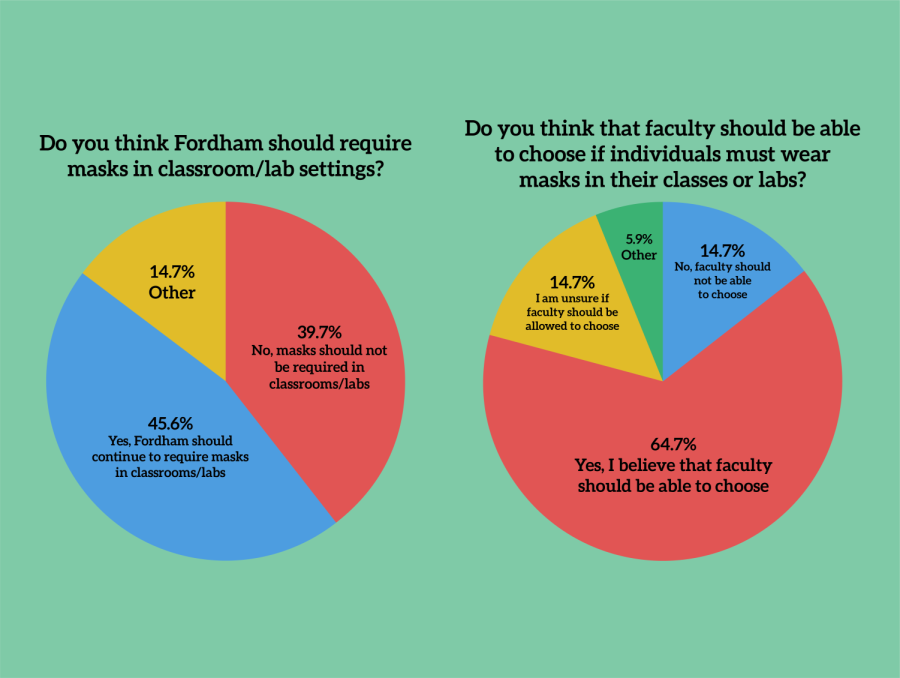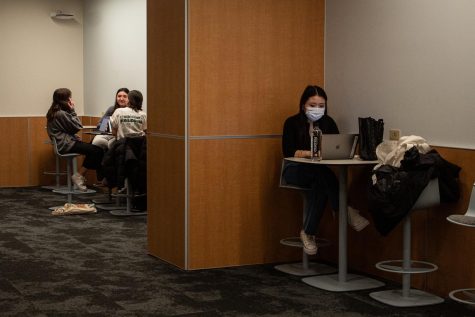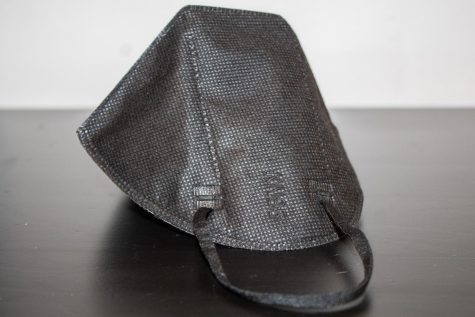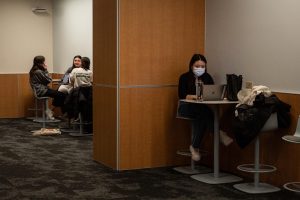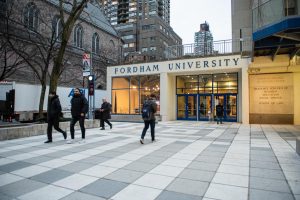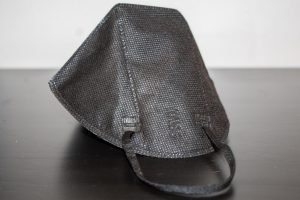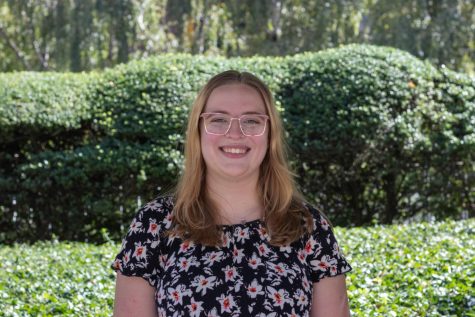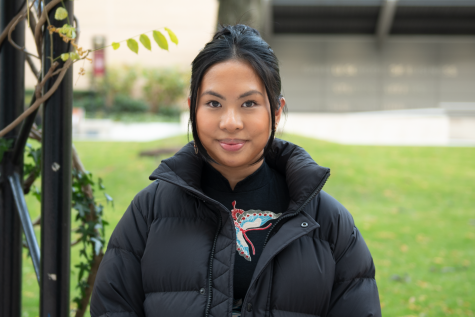Fordham Goes Maskless
In an anonymous survey, 45.6% of respondents said that masks should still be required in labs and classrooms
March 29, 2022
Following NYC Mayor Eric Adams’ decision to make masks optional for all public schools citywide, Fordham announced that it would no longer require masks for most spaces, effective March 5. Masks are now optional in all settings except Ram Vans and University Health Services, although faculty can choose to require masks in their classrooms if they deem it necessary.
According to Marco Valera, vice president for administration and COVID-19 coordinator, the decision to lift the mask mandate was based on the city’s declining COVID-19 cases, as well as updated Centers for Disease Control and Prevention (CDC) guidelines. He also explained that Fordham has been working consistently with an epidemiologist from a consulting firm from the start of the COVID-19 pandemic.
“It was three or four weeks ago that we started to look at the dropping caseloads and then had some conversations and discussions about what that would mean to our policies,” Valera said.
Between Dec. 9 to Dec. 22, Fordham reached an all-time high number of COVID-19 cases.
Prior to the outbreak of the omicron variant in December and the increase in COVID-19 cases that followed, the Fordham administration had originally begun to discuss lifting the mask mandate, according to Valera.
Between Dec. 9 to Dec. 22, Fordham reached an all-time high number of COVID-19 cases. There was a total of 359 cases between both campuses, with 120 cases at Lincoln Center and 239 at Rose Hill.
Due to the sharp uptick in cases, many students and faculty expressed concern over returning to in-person learning for the spring semester. To address faculty concerns, Dennis Jacobs, provost and senior vice president for academic affairs, said in an email on Jan. 17 to faculty that a majority of the cases among students had “been traced back to unmasked socializing off campus.”
He also highlighted that since the overwhelming majority of the Fordham population is required to be vaccinated and boosted, their COVID-19 symptoms are likely to be less severe.
Although the masking was initially instated to help keep students safe in classes, Valera explained that the change in masking policies between the beginning of the semester to now was motivated by the decrease in cases. He also highlighted that since the overwhelming majority of the Fordham population is required to be vaccinated and boosted, their COVID-19 symptoms are likely to be less severe.
Students Respond to the City’s Decision
Students have had conflicting responses to both the city and Fordham’s decision to lift the mask mandate. The Observer conducted an anonymous survey on March 7 to collect student opinions on the updated policy and received 68 responses from undergraduate students by March 22.
In the survey, 36.8% of respondents said that they completely supported the decision to lift the mask mandate at all public schools, while 29.4% said that they completely disagree. The remaining respondents either somewhat agreed or were unsure as to their opinion.
Many of the students who completely supported the decision cited the decline in case numbers in the state for shaping their point of view.
Many of the students who completely supported the decision cited the decline in case numbers in the state for shaping their point of view. At the peak of the omicron variant on Jan. 9, New York state had a daily average of 74,182 new cases. Less than two months later, on March 5, New York state (NYS)’s new daily average decreased to 1,803.
“I normally try (to) be considerate of other people’s health and comfort. But, with that being said, cases are very low in NYS overall, and most people at this point have had COVID,” a respondent said. “Also, the vaccine coupled with natural immunity and a weaker variant make serious illness less of a threat.”
Other students disagreed that public schools should get rid of the mask mandate as NYC public schools do not require all students to receive the COVID-19 vaccination unless they are involved in “high-risk” extracurriculars or sports. One respondent said they were worried that children under the age of 5 who cannot yet be vaccinated may get COVID-19 from a sibling.
Other students disagreed, stating that masking was impacting their education.
In New York state, 36% of individuals between the ages of 5 and 11, and 58% of individuals between the ages of 12 to 17, are fully vaccinated, meaning they have received the full dosage of the first series of their vaccination but may not have yet received the booster dose.
The CDC recommends that all individuals eligible receive the booster dose to help fight against the omicron variant. Individuals over the age of 12 are eligible to receive their dose, however, only children between the ages of 5 and 11 with weakened immune systems can be boosted.
Unmasking in Classrooms
Students are alsosplit in their level of support for Fordham’s decision to no longer require masks in classrooms. In the survey, 39.5% of respondents said that they believe masks should not be required in classrooms or labs, while 45.6% said that they should be.
Other students disagreed, stating that masking was impacting their education.
One reason that respondents said they feel nervous about lifting the mask mandate is that they still feel uneasy after the spike in cases from the omicron variant.
“Just because cases are low now doesn’t mean that there won’t be another variant that can cause them to go back up,” a respondent said.
Some of the other causes for concern regarding the lifting of the mask mandate were how crowded classrooms can be and the poor ventilation in the buildings. One respondent added that most classrooms are not ventilated enough to prevent the spread of COVID-19, causing concern for them because “attendance is not optional.”
“Classrooms are crowded, and students are sitting together in close proximity for extended periods of time,” another respondent said. “Masks in no way impede on the educational experience.”
Other students disagreed, stating that masking was impacting their education.
“Masks are unnecessary,” one student said in the survey. “If they weren’t so uncomfortable, I wouldn’t care, but it’s not like requiring us to wear socks– they (masks) make many people’s faces feel crummy.”
Although many students expressed support for masks to no longer be mandatory in dining spaces, many still argued that masks should be required in other public spaces where there is no dining, such as the library.
In the announcement of the lifting of the mask mandate at Fordham, one of the regulations is that faculty will be allowed to continue to require masks “if they believe the particular circumstances warrant such measures.”
“We thought it would be best to leave it up to the faculty’s decision based on their particular circumstances and classroom setting,” Valera said. “So that’s a measure that we thought would be prudent to take at this point.”
In the survey, 64.7% of students said that they believe faculty should be able to decide if masks are required in their classroom. Many of the respondents explained that faculty should be able to choose in case they have family members who are immunocompromised or at high risk.
“One of my professors has four children under the age of five, making them (ineligible) to be vaccinated,” a respondent said. “In that case, masking makes sense.”
Nany believe dining spaces are more socially distanced than classrooms.
Other students were upset with Fordham’s decision to allow faculty to decide if masks are required in their classrooms. Out of all respondents, 14.7% said that faculty should not be allowed to choose if masks are required in their classrooms.
“If the school does not require it, faculty should not be able to override that,” one student said. “They can’t make their own rules for other things like grades, exams, requirements etc., so it should be kept consistent.”
Opinions On Unmasking in Public Spaces
Fordham will also no longer require masks in public spaces such as lounges or the Garden Level by Argo Tea. The majority of students supported this decision, with 54.4% of students agreeing that masks should be optional and 22.1% believing they should still be required.
According to respondents in support of the decision, many believe these dining spaces are more socially distanced than classrooms.
“Thanks to spacing in these venues, transmission is more difficult,” a respondent said. “I’m more comfortable in those spaces than many others.”
Although many students expressed support for masks to no longer be mandatory in dining spaces, many still argued that masks should be required in other public spaces where there is no dining, such as the library.
“When people sit down to eat they take off their masks anyways so it doesn’t make a huge difference in a place like argo tea, but I feel like in a library there is really no reason for your mask to be off,” one respondent said.
Fear of Outbreak After Spring Break
The decision to no longer require masks went into effect only one week before spring break, causing many students concern over returning to a maskless campus.
“Students will be coming back to campus from all over the world after spring break, so it doesn’t make sense to let everyone choose whether they want to mask or not,” a respondent said.
Valera explained that the university remains hopeful that there will not be an outbreak following spring break since the majority of the United States is trending lower in caseloads.
Valera added that he felt the risk would be substantially reduced since public transportation such as trains and airplanes still require masks.
“We hope that in any travel, they’ll be in areas that the risk exposure is less than or similar to what one faces in New York City,” he said.
In addition, Valera added that he felt the risk would be substantially reduced since public transportation such as trains and airplanes still require masks. He also said that if a student were to become infected, the symptoms of COVID-19 should be reduced since students are required to be vaccinated and boosted.
In order to mitigate the risk posed by spring break travel, Fordham will require all students to upload a negative COVID-19 PCR test in order to gain access to campus. Students will be required to complete this test between March 16 and March 30, regardless of whether they left campus during the break.
In the event that there is a spike in cases, Fordham is prepared to reinstate other procedures if necessary, according to Valera. At the same time, the university is also examining other restrictions to determine if they can remove any other rules, such as the campus being closed to the public.
Valera emphasized that regardless of the lifting of the mask mandate, students should feel welcome to continue wearing masks in any situation that they feel is necessary.
“I do wear masks in certain situations because I feel that’s something I want to do,” he said. “We want to make sure that our students know that they’re completely supported if they decide to wear a mask in any situation.”

